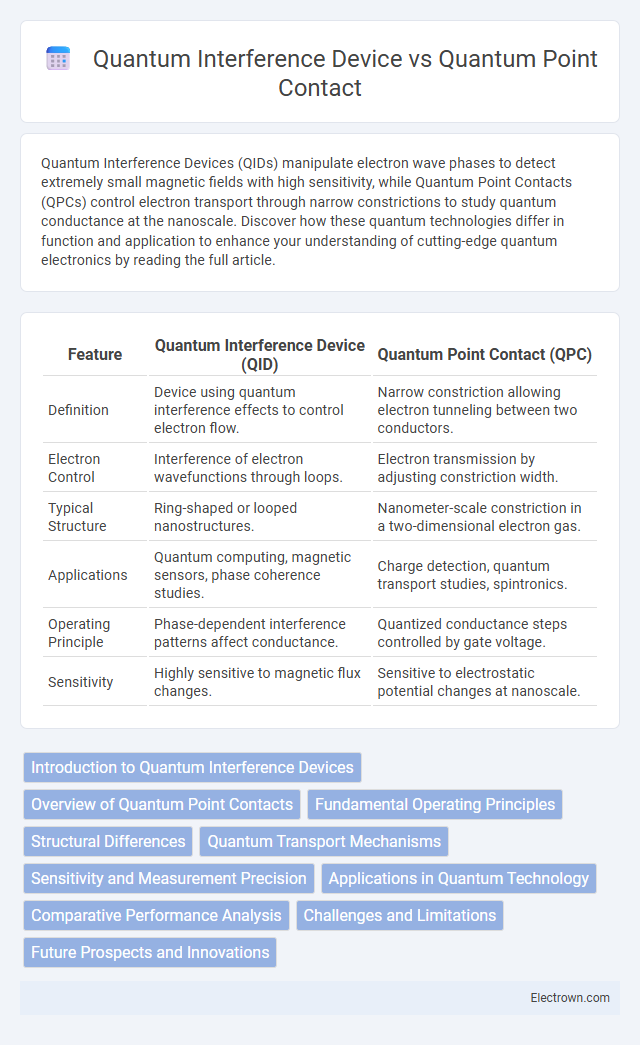Quantum Interference Devices (QIDs) manipulate electron wave phases to detect extremely small magnetic fields with high sensitivity, while Quantum Point Contacts (QPCs) control electron transport through narrow constrictions to study quantum conductance at the nanoscale. Discover how these quantum technologies differ in function and application to enhance your understanding of cutting-edge quantum electronics by reading the full article.
Table of Comparison
| Feature | Quantum Interference Device (QID) | Quantum Point Contact (QPC) |
|---|---|---|
| Definition | Device using quantum interference effects to control electron flow. | Narrow constriction allowing electron tunneling between two conductors. |
| Electron Control | Interference of electron wavefunctions through loops. | Electron transmission by adjusting constriction width. |
| Typical Structure | Ring-shaped or looped nanostructures. | Nanometer-scale constriction in a two-dimensional electron gas. |
| Applications | Quantum computing, magnetic sensors, phase coherence studies. | Charge detection, quantum transport studies, spintronics. |
| Operating Principle | Phase-dependent interference patterns affect conductance. | Quantized conductance steps controlled by gate voltage. |
| Sensitivity | Highly sensitive to magnetic flux changes. | Sensitive to electrostatic potential changes at nanoscale. |
Introduction to Quantum Interference Devices
Quantum Interference Devices (QIDs) exploit the quantum mechanical phenomenon of wavefunction interference to measure extremely small magnetic fields with high sensitivity. These devices differ from Quantum Point Contacts (QPCs), which primarily utilize quantized conductance through narrow constrictions in a two-dimensional electron gas to detect electronic transport properties. QIDs incorporate superconducting loops with Josephson junctions to create interference patterns that reflect magnetic flux changes, making them essential tools in quantum sensing and precision magnetometry.
Overview of Quantum Point Contacts
Quantum Point Contacts (QPCs) are narrow constrictions in a two-dimensional electron gas that allow electron transport through discrete, quantized conductance channels. These devices exhibit quantum interference effects by controlling electron wavefunction overlap, making them essential for studying mesoscopic physics and quantum transport phenomena. QPCs provide precise tunability of conductance in units of 2e^2/h, crucial for applications in quantum computing and nanoscale electronics.
Fundamental Operating Principles
A Quantum Interference Device operates based on the principle of superposition of electron wavefunctions causing interference patterns that modulate electrical resistance, typically exploiting the Aharonov-Bohm effect in mesoscopic rings or loops. In contrast, a Quantum Point Contact functions by constricting electron flow to a narrow channel, creating discrete quantized conductance steps due to wavefunction confinement and electron transmission modes. Your understanding of these devices hinges on recognizing interference-driven resistance modulation for Quantum Interference Devices versus conductance quantization in Quantum Point Contacts.
Structural Differences
Quantum Interference Devices (QIDs) typically feature looped or ring-like structures that exploit phase coherence of electron wavefunctions to observe interference effects, whereas Quantum Point Contacts (QPCs) use narrow constrictions between two electron reservoirs that quantize conductance through discrete modes. The QID's architecture enables control of magnetic flux threading the loop, critical for observing phenomena such as Aharonov-Bohm oscillations, while QPCs rely on electrostatic gating to adjust the width of the constriction, effectively tuning electron transport channels. Understanding these structural differences is essential for optimizing Your device design based on the desired quantum transport characteristics.
Quantum Transport Mechanisms
Quantum Interference Devices exploit wavefunction superposition and phase coherence to modulate electron transport, enabling sensitive detection of magnetic flux through interference patterns. Quantum Point Contacts function through constriction-induced quantized conductance, facilitating electron transport via discrete transverse modes and ballistic conduction channels. Both mechanisms harness quantum effects to control electron flow, with interference effects dominating in Quantum Interference Devices and mode quantization central to Quantum Point Contacts.
Sensitivity and Measurement Precision
Quantum Interference Devices (QIDs) exhibit superior sensitivity due to their ability to detect extremely small magnetic flux changes via quantum phase coherence, enabling ultra-precise measurements in applications like magnetometry. Quantum Point Contacts (QPCs), while highly sensitive to changes in electronic conductance caused by quantum confinement effects, generally offer lower measurement precision compared to QIDs because their response is influenced by environmental noise and temperature variations. The intrinsic quantum interference phenomena in QIDs provide enhanced resolution in detecting subtle variations, marking a significant advantage over QPCs in precision-critical quantum sensing tasks.
Applications in Quantum Technology
Quantum Interference Devices (QIDs) are crucial in quantum technology for precise measurement of magnetic flux, enabling advancements in quantum computing and quantum sensing. Quantum Point Contacts (QPCs) serve as tunable electron transport channels, facilitating quantum state manipulation and enabling the development of qubits and quantum electronic circuits. Both devices play complementary roles in enhancing quantum information processing and quantum metrology applications.
Comparative Performance Analysis
Quantum Interference Devices exhibit highly sensitive phase coherence and magnetic flux detection capabilities, making them ideal for precise quantum measurements, while Quantum Point Contacts excel in controlling electron transport and demonstrating quantized conductance in nanoscale systems. The performance of Quantum Interference Devices dominates in applications requiring extreme sensitivity and interference effects, whereas Quantum Point Contacts offer superior tunability and stability for electron flow manipulation. Evaluating your experimental requirements determines whether the macroscopic phase sensitivity of interference devices or the nanoscale conductance control of point contacts better suits your quantum research objectives.
Challenges and Limitations
Quantum Interference Devices face challenges including sensitivity to environmental noise and decoherence, which limit their accuracy in measuring quantum phase changes. Quantum Point Contacts encounter limitations due to fabrication precision, as atomic-scale variations significantly affect their conductance quantization and electron transport properties. Both technologies struggle with scalability and integration into complex quantum circuits, hindering their practical implementation in real-world quantum computing applications.
Future Prospects and Innovations
Quantum Interference Devices (QIDs) and Quantum Point Contacts (QPCs) both hold significant promise for advancing quantum computing and nanoscale electronics. QIDs are expected to enable more precise control of quantum states through interference effects, enhancing quantum coherence and scalability in future quantum circuits. Your investment in research on QPCs may lead to breakthroughs in quantum sensing and electron transport, driving innovations in ultra-sensitive detectors and quantum information processing.
Quantum Interference Device vs Quantum Point Contact Infographic

 electrown.com
electrown.com